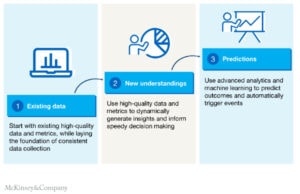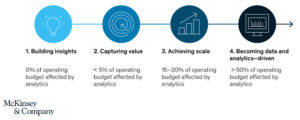
If you’re reading this article, you may be wondering what relationship the two words in the title have, perhaps even what they are.
What is the Data Journey?
Let’s start at the beginning: explaining the Data Journey. The Data Journey is a way of expressing the steps that a company has to take to be able to evolve in managing its data and in the value extracted from it. In short, it is about converting the data stored by a company into relevant information that helps contribute to the business by streamlining and improving processes compared to its competition. In recent years, digitalizing processes has led companies to face a new paradigm: an overexposure of data that needs to be managed, stored, and used by the business.


How can I start a Data Journey at my company?
First stop: generating structured data
The key part of any company’s journey has to start with a solid foundation: generating good data that’s structured, standardized, validated, and reviewed. To do this, you can choose to offer employees a set of standardized company-wide tools that facilitate this task. In the case of Ferrovial Construction, some examples of these tools are inSite, an ERP based on SAP that allows financial information to be fed with quality data. It is also important to facilitate worker management; to this end, you can use tools such as WorkDay. For risk prevention, there are platforms such as Cority, an application that provides standardized data in real time. Even in day-to-day work, it is possible to implement a tool that facilitates the digitization and storage of all the data in order to analyze and use it properly, one example of this is Procore and is very well explained in this blog.
Second stop: standardizing processes
If you were wondering whether this alone is enough, the answer is no. We also have to work on standardizing processes. The problem that most companies usually face is that the historical information available is unstructured. What do we mean by unstructured information? This is data and information in pdf, doc, or even jpg files. The problem here is that this information is being used unilaterally through individual, isolated knowledge of this historical data; however, it is not easily accessible to the rest of the company, thus limiting its use in the future. In short, you can take advantage of much more of it than you currently are.
A structured, good-quality information registry makes it possible to evolve and generate centralized information reports, allowing us to make decisions with data that has been validated and which follows the same criteria. This topic is complex and quite extensive, more so than we can discuss in this article, so I’d recommend this blog post by my colleague Daphne, where this is all explained perfectly.
Third stop: Predictive analytics
The next step in this data journey is predictive analytics, which consists of predicting what is going to happen based on historical data. It may seem like science fiction, but if you commit to it, the results are spectacular. In the case of Ferrovial Construction, Dafne names it above, but we are achieving this predictive analytics thanks to our Digital Hub and Data Management teams. What predictive analytics does is provide valuable information to the company and help make decisions based on data (a data-driven company).
ChatGPT and unstructured data
We still have big questions to address. What about the unstructured, knowledge-gathering data we were talking about earlier? They don’t come into the data journey yet because the information is not structured, so it is not part of the database. But something has changed that could revolutionize this aspect: ChatGPT.
The ChatGPT technology came out of the OpenAI initiative, which sought to be a non-profit association to investigate the potential of Artificial Intelligence (AI). It all started with anonymous donations, but research is expensive, and training AI is even more so. Thus, Microsoft has invested $10 billion USD, thus providing OpenAI with one of the most powerful computers in the world that operates on the Azure network, which is Microsoft’s network. Thanks to this deployment of means, OpenAI has been able to create AI that writes text like a person (or almost). It was initially called GPT (Generative Pretrained Transformer), and this later evolved to have the ability to hold a conversation, renaming itself ChatGPT.
Where does all this fit into our problem of unstructured data?
The key is that OpenAI has used all the capacity Microsoft has “donated” to index all the information on the Internet. Indexing consists of structuring the information contained in a web page in order to perform more efficient searches. In other words, they have organized all kinds of unstructured information using their AI, which can understand the written language on any web page, file, and even photograph. The main added value that ChatGPT can offer to teams is that it allows us to use information and knowledge that was previously left in some drawer, forgotten, by translating the information into direct value for users.
The connection between Data Journey and ChatGPT should be clearer by now, but we’re missing a third element, one that can be crucial.
What is Zuritanken, and what role does it play?
Fostering a company’s culture of innovation is crucial, and providing it with initiatives that get employees involved always pays off. At Ferrovial, Zuritanken is an innovation idea generation program open to all employees that helps foster our culture of innovation. In 2018, a group of colleagues working at Ferrovial (Alejandro, Gema, Eva, Luis, and Ricardo) proposed an innovative idea that won this recognition:

It was a conversational chat that collected individual information generated at construction sites and provided value to construction managers to reduce operational risks. That is, this tool would make it possible to collect individual knowledge and convert it into collective knowledge for the company, allowing all workers to improve their work.
Let’s remember that virtual assistants like Alexa were first launched around that time – some didn’t even exist yet. Precisely because these virtual assistants were very precarious and the information was not structured as we understand it, the winning project, Zuritanken, was not ultimately developed. Today, ChatGPT is moving toward the promise of indexing unconnected information through its AI, offering answers based on that information through queries with ordinary language. Now is the time.
ChatGPT is going to allow the Data Journey at each company to evolve, structuring information that was previously forgotten, and adding value not only for the company as an institution but also for each of the workers that make it up. This tool will usher in the democratization of the data-driven world, which I hope will be much vaster than most are anticipating.





There are no comments yet